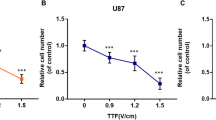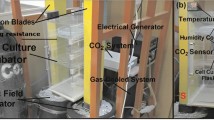Abstract
Static magnetic field (SMF) has been known to affect cell proliferation in a cell-type-dependent manner, while the mechanism still remains unclear. We found that 1 T moderate intensity SMF inhibits cell proliferation of nasopharyngeal carcinoma CNE-2Z cells and the Akt/mTOR signaling pathway, which is upregulated in many cancers. mTOR inhibitors are potential chemodrugs, but their clinical effects are limited by the feedback reactivation of other signaling components such as EGFR and Akt. We showed that 1 T SMF increases the antitumor efficacy of mTOR inhibitor Torin 2. In addition, 1 T SMF increases the inhibition efficiency on mTOR substrates phosphorylation and represses the mTOR inhibitor-induced feedback reactivation of EGFR and Akt. Our study not only demonstrates that mTOR/Akt pathway is one of the molecular targets of SMFs in cells, but also reveals the clinical potentials of combinations of mTOR inhibitors and SMFs in cancer treatment.
摘要
已有报道表明,稳态磁场能够影响细胞分裂,且与细胞类型相关,但其机制并不清楚。我们发现1 T中等强度稳态磁场能够抑制鼻咽癌CNE-2Z细胞的增殖和Akt/mTOR信号通路。Akt/mTOR通路在多种肿瘤中高度活化,因此,mTOR抑制剂是具有潜在应用价值的化疗药物。然而,由于使用过程中出现了其他信号分子如EGFR和AKT的负反馈重新激活,使得这类抑制剂的临床效果受到限制。我们发现1 T稳态磁场能够增强mTOR抑制剂Torin 2的抑瘤效果。生化实验结果表明,1 T稳态磁场不仅增强了Torin 2对mTOR底物磷酸化的抑制,而且减弱了mTOR抑制剂诱导的EGFR和Akt的负反馈重激活。因此,我们的研究不仅证明了mTOR/Akt信号通路是稳态磁场作用于细胞的分子靶点之一,而且揭示了mTOR抑制剂和稳态磁场联合在肿瘤治疗方面的潜在应用。






Similar content being viewed by others
References
Grassi C, D’Ascenzo M, Torsello A et al (2004) Effects of 50 Hz electromagnetic fields on voltage-gated Ca2+ channels and their role in modulation of neuroendocrine cell proliferation and death. Cell Calcium 35:307–315
Rosen AD, Chastney EE (2009) Effect of long term exposure to 0.5 T static magnetic fields on growth and size of GH3 cells. Bioelectromagnetics 30:114–119
Zhang M, Li X, Bai L et al (2013) Effects of low frequency electromagnetic field on proliferation of human epidermal stem cells: an in vitro study. Bioelectromagnetics 34:74–80
Sullivan K, Balin AK, Allen RG (2011) Effects of static magnetic fields on the growth of various types of human cells. Bioelectromagnetics 32:140–147
Aldinucci C, Garcia JB, Palmi M et al (2003) The effect of strong static magnetic field on lymphocytes. Bioelectromagnetics 24:109–117
Ghibelli L, Cerella C, Cordisco S et al (2006) NMR exposure sensitizes tumor cells to apoptosis. Apoptosis 11:359–365
Sun Z, Wang Z, Liu X et al (2015) New development of inhibitors targeting the PI3K/AKT/mTOR pathway in personalized treatment of non-small-cell lung cancer. Anticancer Drugs 26:1–14
Nakahara T, Yaguchi H, Yoshida M et al (2002) Effects of exposure of CHO-K1 cells to a 10-T static magnetic field. Radiology 224:817–822
Zhao G, Chen S, Zhao Y et al (2010) Effects of 13 T static magnetic fields (smf) in the cell cycle distribution and cell viability in immortalized hamster cells and human primary fibroblasts cells. Plasma Sci Technol 12:123–128
Zito CR, Jilaveanu LB, Anagnostou V et al (2012) Multi-level targeting of the phosphatidylinositol-3-kinase pathway in non-small cell lung cancer cells. PLoS ONE 7:e31331
Ocana A, Vera-Badillo F, Al-Mubarak M et al (2014) Activation of the PI3K/mTOR/AKT pathway and survival in solid tumors: systematic review and meta-analysis. PLoS ONE 9:e95219
Porta C, Paglino C, Mosca A (2014) Targeting PI3K/Akt/mTOR signaling in cancer. Front Oncol 4:64
Guertin DA, Sabatini DM (2007) Defining the role of mTOR in cancer. Cancer Cell 12:9–22
Ma XM, Blenis J (2009) Molecular mechanisms of mTOR-mediated translational control. Nat Rev Mol Cell Biol 10:307–318
Sabatini DM, Erdjument-Bromage H, Lui M et al (1994) RAFT1: a mammalian protein that binds to FKBP12 in a rapamycin-dependent fashion and is homologous to yeast TORs. Cell 78:35–43
Sarbassov DD, Ali SM, Kim DH et al (2004) Rictor, a novel binding partner of mTOR, defines a rapamycin-insensitive and raptor-independent pathway that regulates the cytoskeleton. Curr Biol 14:1296–1302
Zoncu R, Efeyan A, Sabatini DM (2011) mTOR: from growth signal integration to cancer, diabetes and ageing. Nat Rev Mol Cell Biol 12:21–35
Sarbassov DD, Guertin DA, Ali SM et al (2005) Phosphorylation and regulation of Akt/PKB by the rictor-mTOR complex. Science 307:1098–1101
Gadgeel SM, Wozniak A (2013) Preclinical rationale for PI3K/Akt/mTOR pathway inhibitors as therapy for epidermal growth factor receptor inhibitor-resistant non-small-cell lung cancer. Clin Lung Cancer 14:322–332
Chresta CM, Davies BR, Hickson I et al (2010) AZD8055 is a potent, selective, and orally bioavailable ATP-competitive mammalian target of rapamycin kinase inhibitor with in vitro and in vivo antitumor activity. Cancer Res 70:288–298
Liu Q, Xu C, Kirubakaran S et al (2013) Characterization of Torin 2, an ATP-competitive inhibitor of mTOR, ATM, and ATR. Cancer Res 73:2574–2586
Thoreen CC, Kang SA, Chang JW et al (2009) An ATP-competitive mammalian target of rapamycin inhibitor reveals rapamycin-resistant functions of mTORC1. J Biol Chem 284:8023–8032
English DP, Roque DM, Carrara L et al (2013) HER2/neu gene amplification determines the sensitivity of uterine serous carcinoma cell lines to AZD8055, a novel dual mTORC1/2 inhibitor. Gynecol Oncol 131:753–758
Schenone S, Brullo C, Musumeci F et al (2011) ATP-competitive inhibitors of mTOR: an update. Curr Med Chem 18:2995–3014
Wan X, Harkavy B, Shen N et al (2007) Rapamycin induces feedback activation of Akt signaling through an IGF-1R-dependent mechanism. Oncogene 26:1932–1940
Rodrik-Outmezguine VS, Chandarlapaty S, Pagano NC et al (2011) mTOR kinase inhibition causes feedback-dependent biphasic regulation of AKT signaling. Cancer Discov 1:248–259
Wander SA, Hennessy BT, Slingerland JM (2011) Next-generation mTOR inhibitors in clinical oncology: how pathway complexity informs therapeutic strategy. J Clin Invest 121:1231–1241
Fumarola C, Bonelli MA, Petronini PG et al (2014) Targeting PI3K/AKT/mTOR pathway in non small cell lung cancer. Biochem Pharmacol 90:197–207
Zardavas D, Fumagalli D, Loi S (2012) Phosphatidylinositol 3-kinase/AKT/mammalian target of rapamycin pathway inhibition: a breakthrough in the management of luminal (ER+/HER2−) breast cancers? Curr Opin Oncol 24:623–634
Hao Q, Wenfang C, Xia A et al (2011) Effects of a moderate-intensity static magnetic field and adriamycin on K562 cells. Bioelectromagnetics 32:191–199
Gray JR, Frith CH, Parker JD (2000) In vivo enhancement of chemotherapy with static electric or magnetic fields. Bioelectromagnetics 21:575–583
Sabo J, Mirossay L, Horovcak L et al (2002) Effects of static magnetic field on human leukemic cell line HL-60. Bioelectrochemistry 56:227–231
Vergallo C, Ahmadi M, Mobasheri H et al (2014) Impact of inhomogeneous static magnetic field (31.7–232.0 mT) exposure on human neuroblastoma SH-SY5Y cells during cisplatin administration. PLoS ONE 9:e113530
Acknowledgments
This work was supported by the Chinese Academy of Sciences “Hundred Talent Program” and the National Natural Science Foundation of China (U1532151), and the Chinese High Magnetic Field Laboratory facility.
Author information
Authors and Affiliations
Corresponding author
Ethics declarations
Conflict of interest
The authors declare that they have no conflict of interest.
About this article
Cite this article
Zhang, L., Yang, X., Liu, J. et al. 1 T moderate intensity static magnetic field affects Akt/mTOR pathway and increases the antitumor efficacy of mTOR inhibitors in CNE-2Z cells. Sci. Bull. 60, 2120–2128 (2015). https://doi.org/10.1007/s11434-015-0950-5
Received:
Accepted:
Published:
Issue Date:
DOI: https://doi.org/10.1007/s11434-015-0950-5




